HISTORY OF KWAZULU-NATAL- KZN HISTORY
Compiled and written by Louis-John Havemann
I make no claim to being an historian. I merely relate stories that were told to me, as well as compiling stories that I have read about or heard told and in most cases cannot quote chapter and verse in respect of where they originated, therefore I am not an historian.
In today's world of "Political Correct" language use, I have been questioned with reference to the terminology of "invaders" particularly referring to Nguni invaders. The persons objecting to the use of the word invaders, by refering to their names, are I have to assume, not people who have English as their home language. I therefore emphasise the fact that English is my home language and on the strength of this refer to the Oxford English dictionary and the interpretation of the word "Invade" which in part is "To enter and spread throughout".
On the strength of this Oxford Dictionary defenition I retain the use of the word invaders. I do not wish to enter into any debate as to whether this is a percieved slight to anyone or any Nation,- it never was so intended - nor whether it is politically correct or not. This is my resume of how I was told the history of this part of my Country and in the most part, this was when most objectors were still swimming in the gene pool so to speak.
I attach purely for interest sake, one of the "imibongi" or praise chants I remember being told as a young boy, that was accorded to Shaka as related in the verbal Zulu history.
"Wena uqeda qeda iziwe
Uzo kuhlaselaphi na
uzo kuhlaselaphi
Wena uhula amakosi
uqeda qeda iziwe
uzo kuhlaselapi na"
"You who have finished, finished off the tribal areas
Where will you now attack (or wage war upon)
You who have conquered the kings or chiefs
Who have finished finished off the tribal areas
Where will you now wage war"
I submit that these are chants of praise to an invader.
CLICK ON THE LINKS BELOW TO FIND OUT MORE ABOUT :
 FOR MORE INFORMATION ON HISTORY OF THE ZULU NATION FOR MORE INFORMATION ON HISTORY OF THE ZULU NATION
 FOR MORE HISTORY ON SHAKA ZULU FOR MORE HISTORY ON SHAKA ZULU
 HISTORY OF THE AMANGWANE PEOPLE AND THE START OF THE MFECANE HISTORY OF THE AMANGWANE PEOPLE AND THE START OF THE MFECANE
|
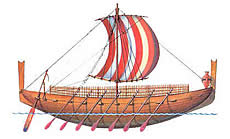
A Phoenician ship |
There is a strong possibility that the first so called
"civilised" visitors to the southern tip of Africa were the
Phoenicians in 610 BC.
There is evidence that the Pharaoh Necho sent these intrepid
mariners on a three year trip around Africa, proceeding down the
east coast, rounding the Cape and sailing north up the west coast
and back through the "Pillars of Hercules" across the Mediterranean,
home. |
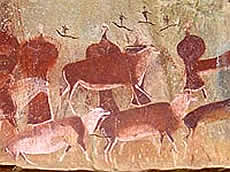 |
|
EARLY NATAL HISTORY |
|
Natal was named by the Portuguese explorer Vasco de Gama after
rounding the Cape in 1497.
On December 25 of that year, he found
his flotilla of four small ships, San Gabriel, San Rafael, Barrio,
and a stores ship (which was later burnt), off the coast of South
Africa and he named this stretch of coast line "Terra Natalis" after
the birth of our Lord. There is no record of him landing.
We
don't know if he was observed by any of the inhabitants of the land
and there is no mention in any African tradition, of this
occurrence.
No one knows with absolute certainty who the first
"Homo
Sapiens" inhabitants of the Eastern Coast of South Africa were, but
it is widely agreed that this honour should go to the Bushmen or San
people of the latter Stone Age era.
They left a legacy
of some of the finest rock art known to man, on the
walls of the sandstone caves of the Drakensberg Mountains right up
to what is now Mpumalanga, as well as the central hinterland of this
country, down to the Western Cape.
There are beautifully drawn galleries depicting their lifestyle
on these cave walls, but sadly there is no accurate record, apart
from their art sites, of how large an area these primitive hunter
gatherers occupied.
Evidence of their rock art sites covers a vast area of South
Africa showing how large an area they
|
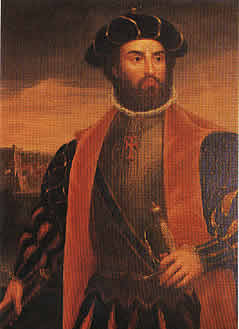
VASCO DE GAMA
Painting courtesy of Cape Town Castle |
actually inhabited when they
were at the height of their culture.
They thrived in this
invigorating climate, free of many of the tropical diseases like
bilharzia and malaria that were to beset later inhabitants of the
lower lying coastal areas.
These San or Bushmen have vanished
from this part of the land and the only record, apart from their
art, that we have are the memories passed down by early invaders who
displaced them.
These first inhabitants appeared as phantoms to
the newcomers and they were regarded with superstition, to be
annihilated when found.
It is not certain who the new Bantu invaders were but it was
thought by the later Zulu speaking migrants, that they were an
offshoot of the Karanga/ Rodzvi tribe from what is now Zimbabwe,
known as the Lala people. They were mainly splinter groups who moved
on after internecine fights, to seek sanctuary further south. Their
appearance in this part of the world is accepted to have been in the
15th century and like the Bushmen not much is known about them and
even their language has all but disappeared.
It is only in the seventeenth century that more reliable and
accurate records are available of a new band of invaders known as
the Nguni after their leader. | |
|
|
| The Nguni invaders, named after their legendary leader Nguni, came down
from northern Central Africa bringing with them cattle, which were not originally
indigenous to Africa.
The Sahara Desert in the north of Africa was an almost impossible
barrier for herdsman to cross with their livestock.
To the north of the Tropical Rain Forests and the Congo River, which
was also a major barrier to migration from the North southwards, lay a
fertile subtropical savannah which was home to great numbers of
pastoralists.
As their population numbers built up they had to move
from their land known as "eMbo" and find new land to occupy but were faced
with the Sahara in the north and the Tropical Rain Forests in the south.
The only narrow way for them to move south was through the Rift Valley and
the Lake belt of Eastern Africa known as the"Interlacustrine Region or Belt" .
They utilised this corridor and moved steadily south through what is
now Mozambique under their leader known as Dlamini.
Contact with San hunters produced the "click" sounds
characteristic of their language today.
They stuck east of the
600mm line of rainfall and finally after following the Lebombo(Swazi)
Ubombo (Zulu) Range, they finally found what they thought was the ideal
country side to settle in.
Here the tribes, all with a common language base, dispersed and the North and South Nguni groups came about.
|
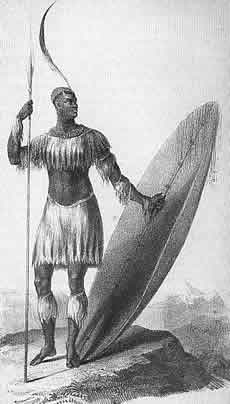
Shaka Zulu 1825
Drawn by James King |
The Zulu, the Swazi and the Ndbele are of the
Northern Nguni group, while the
Xhosa, Pondo and Thembu form the Southern group
A Leader
Ngwane, established himself in the Pongola River basin and founded what
was to become the Swazi Nation. The Ngawne's also had other splinter groups who established themselves in an area on the White Umfolozi River near to Nhlazatshe Mountain near to present day Vryheid
CLICK HERE FOR FURTHER NGWANE HISTORY
Of importance to this province is the trail of a chief of one of the
small fragmentary tribes called Malandela (The Follower). CLICK HERE FOR MORE ON MALANDELA
Please note
that his name is not Mandela but Malandela. Malandela with his wives and
followers finally settled in a beautiful valley named after the river that
flowed through it viz. uMhlatuze (The Powerful One).
Malandela had a son called Ntombhela who had
two
sons Qwabe, the eldest and his youngest son named Zulu (Heaven).
Zulu or Nkosinkulu moved and settled in the eMakhosini Valley on the banks of the uMpembene stream.
Here was born the Zulu Nation , that was to change the face of this part of Africa under King Shaka and rock the British Empire military power in the future, under Cetshwayo. |
|
|
|
THE EARLIEST EUROPEAN VISITORS TO NATAL:
In 1575 as a result of numerous shipwrecks, the King of Portugal
commissioned a surveyor A.Manuel. Perestrelo, to survey the eastern South
African coastline,in order to find safe harbours for storm threatened
ships. There is not a record of him landing, however he must have replenished
water and food supplies at some point.
He drew up the first reasonably
accurate map of the Natal Coastline and it was him who fixed Natal as
being the area between the Umtata River and the Tugela River. He named
Durban as Ponta Pescaria and St Lucia as Lagoa Santa Lucia.
The following European visitors were survivours of some of the shipwrecks until the
1800 s when settlers started becoming interested in Natal.
|
1536:- It is thought that Diogo Pereira a Portuguese explorer
replenished supplies at Ponta de Pescaria (Port Natal) on his way to
India.
1552:- Five hundred survivors including 300 slaves from the "San
Joao" under Captain Manuel de Sousa de Sepulveda set off to walk
from the Mtamvuma River to Mocambique in July 1552. The remnants of
this party (two hundred) arrived at Chief Nyaka's kraal (After whom
Inhaca Island is named) at Delagoa Bay in October 1552 and were
hospitably received. After resting they set off again for Mocambique
and further up the coast they were attacked and stripped of
everything, even their clothes.
Dona Leonor, de Sousa's wife of great beauty, had a hole dug in
the sand and buried herself there. Her husband and children died
there as they would not leave without her.
Twenty two survivours
reached Inhambane where they were ransomed by the natives, for beads
valued at two pennies and three farthings per person.
1685:- Captain John Adams, who was a survivor of the "Good Hope"
which ran aground near the Bluff and some other survivors salvaged
material from the "Good Hope" and built a small ship which they
eventually sailed to Madagascar.
1686:- The first mate of the "Good Hope", John Kingston with four
other survivors combined efforts with Captain Kniff and some of the
survivors of his ship the "Stavenisse" to build a small ship, which
they sailed to Cape Town. This ship was apparently bought by Simon
van der Stel, the Governor of the Cape for four hundred florins and
named the "Centaur".
1689 Captain Timmerman of the "Noord" purchased Port Natal from a
local chief. See below for more.
1699:-"Fidele" an English ship
left three of her crew members at Port Natal to trade and never came
back for them. It was found that six years later one crew
member,Vaughan Goodwin was still alive and living with two African
wives and seven children.
|
| |
|
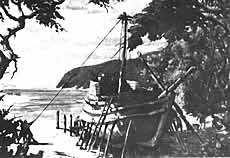
First ship built at Port Natal 1685
Painting by Nils Anderson
Old House Museum
|
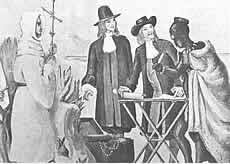
A painting of the purchase of Natal in 1689 by Daphne Strutt.
Local History Museum Durban
|
| |
Simon van der Stel the governor of the Cape had heard good reports of Natal and also requiring further information about the wrecked ship Stavenisse, he sent the "Noord" to search for survivors and also to explore the possibility of trade in Natal.
On 5 January 1689 the "Noord" sailed into Rio de Natal and found survivors of the "Stavenisse".
Capt Pieter Jan Timmerman of the Noord was sent back to Natal in November 1869 to purchase land from the local chief Inyangesi.
The deed of sale was signed for
1000 guilders worth of beads, iron mongery and other trade goods.
The"Noord was wrecked near Algoa Bay on the way home and only four survivors
made it back to Cape Town. Much later in 1705 when the Dutch sent Capt. Gerbrantzer of the "Postlooper" to make enquiries and verify
the purchase of the land, they found the chief had died.
His son repudiated
the deal saying that he was not responsible for what his father had signed so nothing came of that land purchase.
Port Natal became known to the Dutch East India Company sailors as "Engelsche Logie" (Englishman's Inn) because of so many survivors from wrecked British ships living there.
|
| |
The British Settlement of Natal 1824
In 1822 Lieutenant James King Capt of the "Salisbury" together with Lt. Francis George Farewell both ex Royal Navy officers from the Napoleonic wars were engaged in trade between the Cape and Delagoa Bay.
On a return trip to the Cape in 1823 they were caught in a very bad storm and decided to risk the Bar and anchor in the Bay of Natal. The crossing went off well and they found safe anchor from the storm.
Lt. King decided to to map the Bay and named Salisbury and Farewell Islands.
In 1824 Lt. Farewell together with a trading company called J.R.Thompson & Co. decided to open trade relations with Shaka the Zulu King and to establish a trading station at the Bay.
Henry Francis Fynn another trader at Delagoa Bay, was also involved in this venture.
|
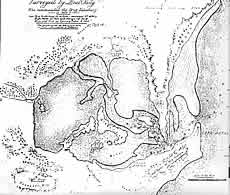
Chart of Port Natal 1822
by Capt James Saunders King
Click here for bigger picture |
Fynn sailed for The Bay of Natal on the brig "Julia" and Farewell followed six weeks later on the "Antelope". Between them they had 26 possible settlers, only 18 stayed.
On 7 August 1824 they concluded negotiations with King Shaka for a cession of land including the Bay of Natal and land extending ten miles south of the Bay, twenty five miles north of the Bay and one hundred miles inland.
Farewell took possesion of this grant on 7 August 1824, raised the Union Jack and fired a Royal Salute,
which consisted of 4 cannon shots and twenty musket shots.
Of the original 18 would be settlers only 6 remained and they can be regarded as the founder members of Port Natal as a British settlement. These 6 were joined by Lt. James Saunders King and Nathaniel Isaacs in 1825. |
|
The 18 who decided to stay were:- |
Buxman
J.Cane
Collins
Davids
De Bruin
F.G.Farewell
H.F.Fynn
T.Halstead
J.Hoffman
|
Jos. Hoffman
J.P.Hoffman
N.Isaacs
Johnstone
J.S.King
Nel
H.Ogle
Pieterson
J.Powell
|
|
The life appeared too lonely for some of these prospective settlers, so one month later on
7 September 1824, 9 people boarded the Julia and sailed back to Cape Town. On 9 December 1824 a further 11 people again boarded the Julia for the Cape, but unfortunately the Julia caught alight and sank and all passengers drowned. |
The founders who remained behind were:-
- J.Cane killed at Ndondakasuka 1838
- F.G.Farewell murdered at uMzimvubu River 1829
- H.F.Fynn left Natal 1834 but returned as magistrate.
- T.Halstead Murdered with Piet Retief party 1838
- H.Ogle married a Zulu and became a chief.
- J.Powell Died of malaria 1825
- In 1825 two of the eighteen returned and settled.
- J.S.King Died in 1828
- N.Isaacs left for St. Helena in 1831
|
|
|

